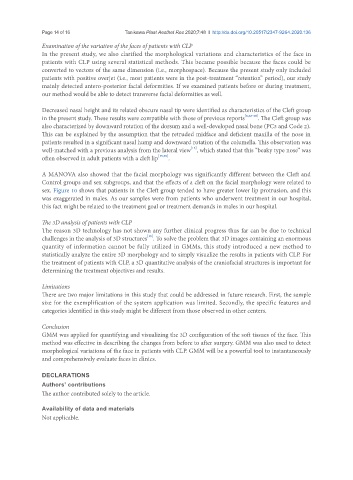Page 560 - Read Online
P. 560
Page 14 of 16 Tanikawa Plast Aesthet Res 2020;7:48 I http://dx.doi.org/10.20517/2347-9264.2020.136
Examination of the variation of the faces of patients with CLP
In the present study, we also clarified the morphological variations and characteristics of the face in
patients with CLP using several statistical methods. This became possible because the faces could be
converted to vectors of the same dimension (i.e., morphospace). Because the present study only included
patients with positive overjet (i.e., most patients were in the post-treatment “retention” period), our study
mainly detected antero-posterior facial deformities. If we examined patients before or during treatment,
our method would be able to detect transverse facial deformities as well.
Decreased nasal height and its related obscure nasal tip were identified as characteristics of the Cleft group
in the present study. These results were compatible with those of previous reports [6,28-30] . The Cleft group was
also characterized by downward rotation of the dorsum and a well-developed nasal bone (PC3 and Code 2).
This can be explained by the assumption that the retruded midface and deficient maxilla of the nose in
patients resulted in a significant nasal hump and downward rotation of the columella. This observation was
[15]
well-matched with a previous analysis from the lateral view , which stated that this “beaky type nose” was
often observed in adult patients with a cleft lip [15,29] .
A MANOVA also showed that the facial morphology was significantly different between the Cleft and
Control groups and sex subgroups, and that the effects of a cleft on the facial morphology were related to
sex. Figure 10 shows that patients in the Cleft group tended to have greater lower lip protrusion, and this
was exaggerated in males. As our samples were from patients who underwent treatment in our hospital,
this fact might be related to the treatment goal or treatment demands in males in our hospital.
The 3D analysis of patients with CLP
The reason 3D technology has not shown any further clinical progress thus far can be due to technical
[19]
challenges in the analysis of 3D structures . To solve the problem that 3D images containing an enormous
quantity of information cannot be fully utilized in GMMs, this study introduced a new method to
statistically analyze the entire 3D morphology and to simply visualize the results in patients with CLP. For
the treatment of patients with CLP, a 3D quantitative analysis of the craniofacial structures is important for
determining the treatment objectives and results.
Limitations
There are two major limitations in this study that could be addressed in future research. First, the sample
size for the exemplification of the system application was limited. Secondly, the specific features and
categories identified in this study might be different from those observed in other centers.
Conclusion
GMM was applied for quantifying and visualizing the 3D configuration of the soft tissues of the face. This
method was effective in describing the changes from before to after surgery. GMM was also used to detect
morphological variations of the face in patients with CLP. GMM will be a powerful tool to instantaneously
and comprehensively evaluate faces in clinics.
DECLARATIONS
Authors’ contributions
The author contributed solely to the article.
Availability of data and materials
Not applicable.

